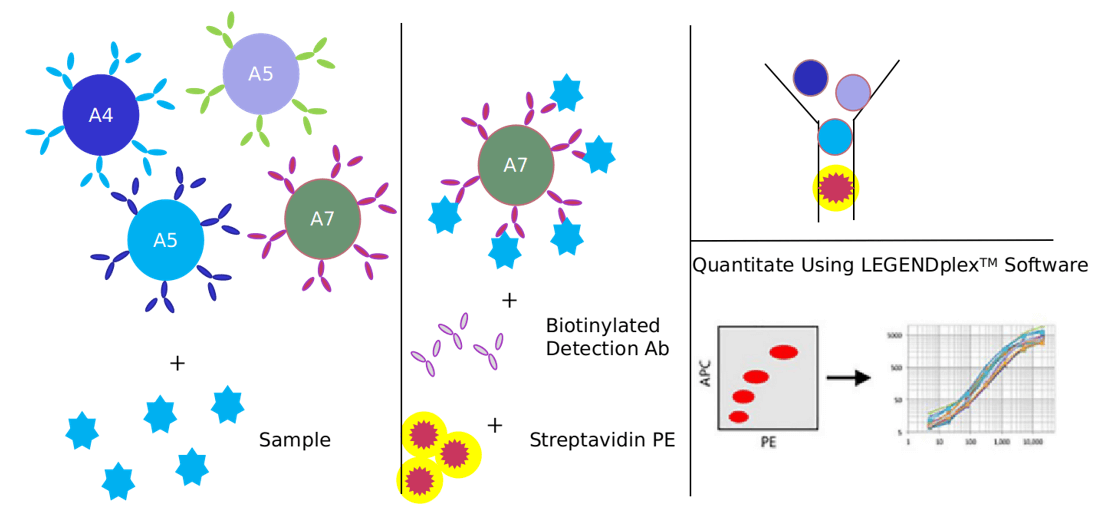Introduction to TLR cell signaling pathway
Based on Luminex technology platform, Creative Proteomics provides analysis services for key targets of TLR cell signaling pathway.
Toll-like Receptors (TLRs) are innate immune pathogen pattern recognition receptors, which can identify the proteins, nucleic acids and lipids of pathogenic microorganisms that invade the body and the intermediate products and metabolites synthesized in the reaction process, such as lipopolysaccharides of gram-negative bacteria ( LPS), peptide polysaccharides of gram-positive bacteria, double-stranded RNA of viruses, etc., are all PAMP (Pathogen-associated molecular pattern) with highly conserved molecular structure. Through the recognition of PAMP, TLR rapidly activates the intracellular signal cascade including adaptor proteins, signal complexes and transcription factor complexes, which ultimately leads to the body's production of pro-inflammatory cytokines, anti-inflammatory cytokines and chemokines.
TLR activates a variety of immune cells through different recognition pathways, initiates non-specific immune responses and stimulates adaptive immune responses to eliminate pathogens. So far, 13 TLRs have been found in mammals, among which TLR1-9 are shared by humans, rats and mice, TLR10 exists in human rats and opossums, and TLR11 exists in mice. TLR is a type I transmembrane protein, which can be divided into three parts: extracellular domain, transmembrane domain and intracellular domain.
Signal transduction methods of the TLR family
- MyD88-dependent TLR signal transduction pathway
The activation of the TLR signal transduction pathway is derived from the cytoplasmic Toll/IL-1 receptor (TIR) domain, which interacts with the adaptor protein MyD88 contained in the TIR domain. After stimulation by the ligand, MyD88 attracts IL-1 receptor-associated kinase-4 (IRAK-4) to TLRs through the interaction of the two molecular death domains. IRAK-1 is activated by phosphorylation and interacts with TRAF6, thereby activating the IKK complex and leading to the activation of MAP kinase (JNK, p38MAPK) and NF-KB.

- MyD88 independent/TRIF (IFN-B) dependent signal transduction pathway
The MyD88-independent pathway is activated by TRIF and TRAF3, leading to the recruitment of IKKE/TBK1, phosphorylation of IRF3 and the expression of interferon beta. The TIR domain contains adaptor proteins such as TIRAP, TRIF and TRAM. This domain can provide specificity for a single TLR signal transduction cascade, thereby regulating TLR-mediated signal transduction pathways.

Our detectable targets:
| LPS | TLR1 | TLR2 | TLR3 | TLR4 | TLR5 |
| TLR6 | TLR9 | Tak1 | IKK-α | IKK-β | ASK1 |
| MKK4 | MKK7 | IRAK | NFκB | PKR | p52 |
| p65 | p50 | PKC | PDK1 | Akt | CBL2 |
| Bcl10 | Mail1 | Carma1 | TAK1 | mTORC1 | IKK |
| MKK7 | MKK4 | JNK2 | p38MAPK | MEK1 | MEK2 |
| GADD45-α | JNK | Erk | CREB | NFAT | Fos |
| Rel | NF-kB | IKB | Jun | PI3K | PACT |
| Tpi2 | PDK-1 | JNKs | ABIN-2 |
Technology platform
We provide Luminex technology for TLR cell signaling pathway analysis.
Luminex technology is a multifunctional liquid phase analysis platform developed on the basis of colored microspheres, laser technology, applied fluidics and high-speed digital signal processing technology. The core is to encode polypropylene microspheres or magnetic microspheres with fluorescent dyes. By adjusting the different ratios of the two fluorescent dyes, up to 100 microspheres with different fluorescence spectra can be obtained. Each kind of microspheres is covalently cross-linked. Capture antibodies against specific antigens.
TLRs (Toll-like Receptors) are innate immune pathogen pattern recognition receptors, which are often used to identify the proteins, nucleic acids and lipids of pathogenic microorganisms that invade the body and the intermediate products and metabolites synthesized in the reaction process.
In addition to Luminex Multiplex Assay, Enzyme-linked immunosorbent assay (ELISA), Flow cytometry (FACS analysis) technology can also be provided to meet other customer needs.
Advantages of TLR cell signaling pathway detection:
- Good repeatability: similar homogeneous reaction mode, each indicator has 1000-5000 reaction units, and the median value of 100 analysis is taken. High accuracy: the detection range is 35-6 orders of magnitude, which is very strong with ELISA and mass spectrometry.
- High flexibility: specific probes, antigens or antibodies can be connected to the microspheres to meet the needs of different customers.
- High sensitivity: the detection limit can reach 0.01pg/ml.

Application of our service:
- To study the effect of each virus on toll-like receptor cell signaling pathway
- To study the regulation mechanism of toll-like receptor cell signal pathway in disease
- To study the effects of drugs or therapies on toll-like receptor cell signaling pathways
Creative Proteomics has developed a signal pathway target detection platform. We are not limited to providing toll-like receptor cell signal path detection services, but can also provide other signal path detection services. If you want to detect other targets, please contact us and we will customize the service for you. Look forward to working with you.
References:
- Schnare M, Barton GM, et al. Toll-like receptors control activation of adaptive immune responses. Nat Immunol, 2001, 2(10): 947-950.
- Shizuo AKira, Kiyoshi Takeda, et al. Toll-like receptors: Critical proteins linking innate and acquired immunity. Nature Immunology, 2001, 2: 675-680.



